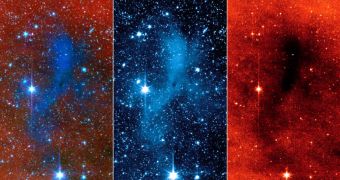Scientists using an advanced telescope for infrared studies have recently determined the existence of the coreshine effect, a phenomenon that may yield fresh insight into how stars and exoplanets form.
These cosmic structures are now known to develop inside very cold clouds of cosmic gas and dust, right at the core of the formations. Optical telescopes cannot see through this cloak.
But observatories operating in infrared wavelengths, such as NASA's Spitzer Space Telescope, are perfectly capable of see even in the deepest corners of stellar nurseries.
It's there that a team of scientists managed to discover a new, cosmic phenomenon, now termed coreshine. The concept is a measure of infrared light that is being deflected off by the cores of star-forming regions.
Generally, these are very cold and dark places, whose interiors include numerous protostars, fully-blown stars, and their accompanying exoplanets, if such structures developed.
What the coreshine effect does is it reveals data about the consistency and age of the cores, as well as about other important traits. All of this is done by analyzing how starlight emitted by nearby stars impacts the surface of the cores, hence the name.
The phenomenon has thus far been found to exist on several dozen cores spread out throughout the Universe, the team behind the work reports in the September 24 issue of the top journal Science.
“Dark clouds in our Milky Way galaxy, far from Earth, are huge places where new stars are born,” explains astronomer Laurent Pagani, who was the leader of the new investigation.
He is based at both the Observatoire de Paris and the Centre National de la Recherche Scientifique (CNRS), in France. “But they are shy and hide themselves in a shroud of dust so that we cannot see what happens inside,” he explains.
“We have found a new way to peer into them. They are like ghosts because we see them but we also see through them,” the expert goes on to say, quoted by researchers at the NASA Jet Propulsion Laboratory (JPL), in Pasadena, California.
“We're opening a new window on the realm of dark, star-forming cores,” Pagani says, adding that, of the 110 dark cores his group analyzed, more than half exhibited coreshine.
The team also estimates that dust particles in the stellar nursery cores will be larger as they grow older, and so using coreshine may represent a new approach to mapping the age of nursery across the Universe.

 14 DAY TRIAL //
14 DAY TRIAL //